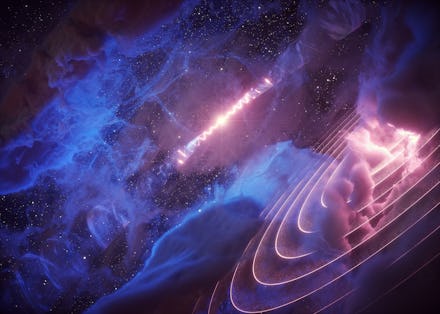A black hole and a cosmic gas cloud are beating in sync and scientists don't know why

Scientists have discovered a mysterious "heartbeat" pulsing from a cosmic gas cloud that is beating in time with the swaying jets of a neighboring black hole. Located in the constellation Aquila, researchers think that the synchronized heartbeat is connected to the black hole in some way. How it is connected, however, is unclear.
An international team of scientists released a report on their discovery in the journal Nature Astronomy on August 17. Looking at 10 years' worth of data from NASA's Fermi gamma-ray space telescope, they focused their attention on a microquasar in a system called SS 433. A microquasar is basically a smaller quasar, and SS 433 was the first microquasar ever discovered. SS 433 is about 15,000 light years away from the Milky Way galaxy and consists of a black hole and an enormous star approximately 30 times the mass of our sun.
The star and the black hole orbit each other every 13 days, and each time they do, the black hole sucks up some matter from the star. Before disappearing into the center of the black hole, the star matter circles it like water circling a drain.
But not all the matter makes it into the hole. A bit of it ends up shooting out of the two sides of the black hole, sending out jets made up of x-rays and gamma rays.
These jets don't stay in a straight line. The swirling matter isn't perfectly aligned with the black hole and star, so it actually wobbles a bit like a shaky, spinning top.
As it sways, unbalanced, the jets swirl as they're shooting out.
A top that spins on a table can rotate and wobble quickly, but something as large as the swirling matter around a black hole is a lot slower; it takes about 162 days for the jets to make a full sway.
Meanwhile, 100 light years away from the black hole is a cosmic gas cloud. At first glance, researchers say it seems "inconspicuous" and "unremarkable," but when they looked closer they noticed a spot within the gas cloud that's emitting gamma rays at the same pulse as the jets' sway. The location, now called Fermi J1913+0515, appears to be connected or powered by the jets somehow, despite the distance from the black hole. The location of the gamma rays isn't even in the same direction as the jets, which makes the discovery extra weird.
"Finding such an unambiguous connection via timing, about 100 light years away from the micro quasar, not even along the direction of the jets is as unexpected as amazing," lead researcher Jian Li said in a press release. "But how the black hole can power the gas cloud's heartbeat is unclear to us."
Scientists being scientists, the team has already made a guess into why it's happening. They figure that since the location in the cloud isn't in the same direction as the jets, it's not likely a result of the jets directly beaming their gamma rays on it. But there's another possibility: The end of the jets could be shooting out fast protons that get injected into the cloud. Within the cloud, they collide with gas to create gamma rays that pulse in time with the swaying.
But more observations are needed to truly know what's going on. Li hopes that these future studies could also lead to a better understanding of how cosmic rays are created and how microquasars might play a role in their production.